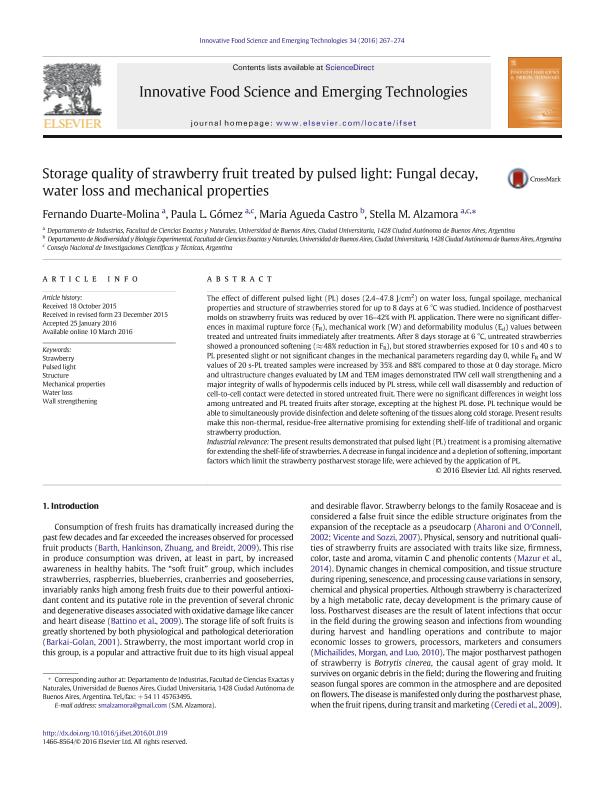Mostrar el registro sencillo del ítem
dc.contributor.author
Duarte Molina, Fernando
dc.contributor.author
Gómez, Paula Luisina

dc.contributor.author
Castro, Maria Agueda
dc.contributor.author
Alzamora, Stella Maris

dc.date.available
2018-09-14T18:22:12Z
dc.date.issued
2016-04
dc.identifier.citation
Duarte Molina, Fernando; Gómez, Paula Luisina; Castro, Maria Agueda; Alzamora, Stella Maris; Storage quality of strawberry fruit treated by pulsed light: Fungal decay, water loss and mechanical properties; Elsevier; Innovative Food Science & Emerging Technologies; 34; 4-2016; 267-274
dc.identifier.issn
1466-8564
dc.identifier.uri
http://hdl.handle.net/11336/59743
dc.description.abstract
The effect of different pulsed light (PL) doses (2.4-47.8 J/cm2) on water loss, fungal spoilage, mechanical properties and structure of strawberries stored for up to 8 days at 6 °C was studied. Incidence of postharvest molds on strawberry fruits was reduced by over 16-42% with PL application. There were no significant differences in maximal rupture force (FR), mechanical work (W) and deformability modulus (Ed) values between treated and untreated fruits immediately after treatments. After 8 days storage at 6 °C, untreated strawberries showed a pronounced softening (≈ 48% reduction in FR), but stored strawberries exposed for 10 s and 40 s to PL presented slight or not significant changes in the mechanical parameters regarding day 0, while FR and W values of 20 s-PL treated samples were increased by 35% and 88% compared to those at 0 day storage. Micro and ultrastructure changes evaluated by LM and TEM images demonstrated ITW cell wall strengthening and a major integrity of walls of hypodermis cells induced by PL stress, while cell wall disassembly and reduction of cell-to-cell contact were detected in stored untreated fruit. There were no significant differences in weight loss among untreated and PL treated fruits after storage, excepting at the highest PL dose. PL technique would be able to simultaneously provide disinfection and delete softening of the tissues along cold storage. Present results make this non-thermal, residue-free alternative promising for extending shelf-life of traditional and organic strawberry production. Industrial relevance The present results demonstrated that pulsed light (PL) treatment is a promising alternative for extending the shelf-life of strawberries. A decrease in fungal incidence and a depletion of softening, important factors which limit the strawberry postharvest storage life, were achieved by the application of PL.
dc.format
application/pdf
dc.language.iso
eng
dc.publisher
Elsevier

dc.rights
info:eu-repo/semantics/openAccess
dc.rights.uri
https://creativecommons.org/licenses/by-nc-nd/2.5/ar/
dc.subject
Mechanical Properties
dc.subject
Pulsed Light
dc.subject
Strawberry
dc.subject
Structure
dc.subject
Wall Strengthening
dc.subject
Water Loss
dc.subject.classification
Alimentos y Bebidas

dc.subject.classification
Otras Ingenierías y Tecnologías

dc.subject.classification
INGENIERÍAS Y TECNOLOGÍAS

dc.title
Storage quality of strawberry fruit treated by pulsed light: Fungal decay, water loss and mechanical properties
dc.type
info:eu-repo/semantics/article
dc.type
info:ar-repo/semantics/artículo
dc.type
info:eu-repo/semantics/publishedVersion
dc.date.updated
2018-09-14T13:16:06Z
dc.journal.volume
34
dc.journal.pagination
267-274
dc.journal.pais
Países Bajos

dc.journal.ciudad
Amsterdam
dc.description.fil
Fil: Duarte Molina, Fernando. Universidad de Buenos Aires. Facultad de Ciencias Exactas y Naturales. Departamento de Industrias; Argentina
dc.description.fil
Fil: Gómez, Paula Luisina. Universidad de Buenos Aires. Facultad de Ciencias Exactas y Naturales. Departamento de Industrias; Argentina. Consejo Nacional de Investigaciones Científicas y Técnicas; Argentina
dc.description.fil
Fil: Castro, Maria Agueda. Universidad de Buenos Aires. Facultad de Ciencias Exactas y Naturales. Departamento de Biodiversidad y Biología Experimental; Argentina
dc.description.fil
Fil: Alzamora, Stella Maris. Universidad de Buenos Aires. Facultad de Ciencias Exactas y Naturales. Departamento de Industrias; Argentina. Consejo Nacional de Investigaciones Científicas y Técnicas; Argentina
dc.journal.title
Innovative Food Science & Emerging Technologies

dc.relation.alternativeid
info:eu-repo/semantics/altIdentifier/doi/http://dx.doi.org/10.1016/j.ifset.2016.01.019
dc.relation.alternativeid
info:eu-repo/semantics/altIdentifier/url/https://www.sciencedirect.com/science/article/pii/S1466856416300315
Archivos asociados
